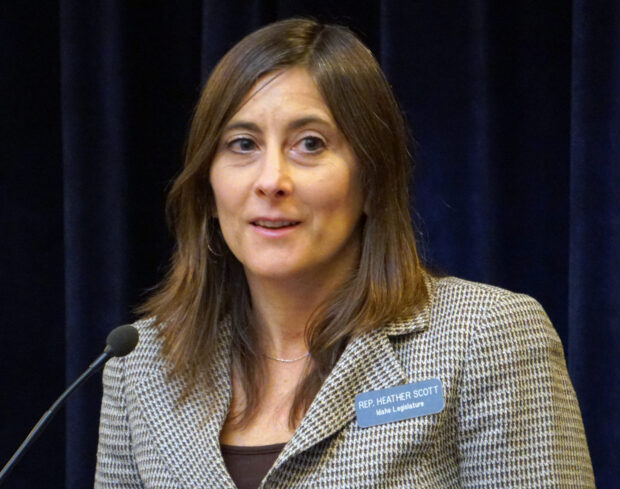The House passed a bill Thursday that would force taxing districts, such as school districts, to wait at least 11 months after a bond issue fails before they could run it again.

Rep. Heather Scott, R-Blanchard, pushed House Bill 347, which passed 48-21.
Scott, who ran a similar bill that failed in the Senate in 2018, said the bill is necessary to protect taxpayers from “aggressive taxing districts that can and do continually run bonds over and over again when they fail at the ballot boxes.”
Opponents of the bill say its passage could tie the hands of school boards hoping to address rapid growth, unsafe or damaged facilities. Other opponents said the bill amounted to the Legislature acting like George Orwell’s “Big Brother” and telling local government agencies what they can and cannot do.
“We’re a local control state except when we’re not local control,” Rep. Ryan Kerby, R-New Plymouth, said. “Big Brother just had to go in and fix something that a very small minority of people are doing.”
Other legislators said only a small minority of taxing districts run failed bond issues within a year of each other. Rep. Sally Toone, D-Gooding, said she only identified 16 repeat bond issues over the past 18 years.
In some cases, school boards have run consecutive bond issues. A bond issue must exceed a two-thirds supermajority to pass in Idaho. Some districts, including East Idaho’s Bonneville School District, have had to try multiple times to reach that threshold.
Confusingly, not everything Scott said on the House floor during her debate was accurate. Scott falsely told the House minutes before the vote that Idaho Falls ran a $46 million bond in January 2020 that failed and is being run again in May. While Idaho Falls School District officials are considering running a $46 million bond in May, the Post Register reports, the district did not run a failed measure this month. Furthermore, January is not one Idaho’s allowable election dates, which are all listed on the first page of Scott’s three-page bill.
At any rate, Scott’s bill was not limited to school districts. As she pointed out, it would apply equally to library districts, mosquito districts or any other taxing district that has the ability to bring bond issues before voters.
HB 347 heads to the Senate for consideration.
Career-technical budget
About 101,000 students took career-technical courses in 2018-19, a one-year increase of more than 1,500 students.
However, Idaho’s career-technical programs will likely have to absorb budget cuts next year.
Gov. Brad Little has proposed a $67.4 million general fund budget for career-technical programs next year, a 1.5 percent decrease. Much of the difference traces back to Little’s spending “reset:” the budget cuts he has imposed across most state agencies. CTE is cutting 1 percent from its budget this year, and an additional 2 percent next year.
The Little budget includes one line item request from CTE: an additional $400,000 for high school programs. The money represents “an effort to continue to sustain the programs we have now,” new CTE administrator Clay Long told the Joint Finance-Appropriations Committee.
JFAC considered the budget request during a brief hearing Thursday. The committee will begin writing agency budget bills in February.
Academic standards and rules update
The debate over academic standards and administrative rules will continue into the fifth week of the legislative session.
Although it spent each of the previous two weeks conducting divided hearings over science standards and Common Core-aligned English and math academic standards, the House Education Committee has not addressed the standards since Jan. 22.
Meanwhile, the committee has generally held off from introducing major education-related bills while it sorts out rules.
At the same time, the Senate is applying pressure on the House to get moving on rules.
But it won’t happen this week.
House Education isn’t meeting Friday.
And Chairman Lance Clow, R-Twin Falls, said the committee is likely to spend Monday reviewing higher education and K-12 budgets.
That leaves Tuesday as the next best option.
Driver’s education bill comes back for 2020
A perennial topic — offsetting the cost of driver’s education classes — has flunked its road test before.
But sponsors will take another run at the idea this year.
The Senate Education Committee introduced a bill that would provide schools a $150 state reimbursement for driver’s ed classes. The schools now receive $125, a payment that hasn’t changed since 1996.
The current reimbursement doesn’t cover the entire cost of driver’s ed, and the proposed increase wouldn’t cover the costs either. On average, a driver’s ed course costs $173. But sponsors say an increased reimbursement would cut costs for schools, and cut student fees as well.
The state’s reimbursement comes from a dedicated fund, bankrolled from a portion of driver’s license fees.
A similar bill to boost the reimbursement to $150 cruised through the Senate last year on a 31-3 vote, Then it hit a roadblock in the House, failing on a 38-30 vote.
One difference this year: Sponsors say there is a $4.9 million surplus in the driver’s education fund, up from $4.3 million a year ago.
Idaho Education News reporter Kevin Richert contributed to this story.
